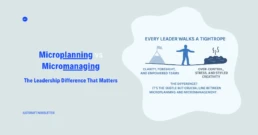Microplanning vs Micromanaging: Transform Your Leadership Style
Picture this: Two team leads, same company, same deadlines. Sarah creates detailed project timelines, sets clear checkpoints, then trusts her team to execute. Mark does the same planning but then hovers over every email, approves every decision, and checks in hourly.
Both think they’re being thorough leaders. Only one has a team that actually wants to work with them.
One Topic: Microplanning vs Micromanaging
The Leadership Tightrope We All Walk
Every leader faces this challenge. You want results, you care about quality, and you know planning matters. But somewhere between “being prepared” and “being controlling,” there’s a line that’s easier to cross than you think.
I’ve watched countless leaders struggle with this balance. The difference between microplanning and micromanaging isn’t just semantic—it shapes everything from team morale to business outcomes.
What Microplanning Actually Looks Like
Think of microplanning as building a GPS system for your team. You map out the destination, identify potential roadblocks, and provide the tools they need to navigate. But you don’t grab the steering wheel.
Lisa, a product manager I know, exemplifies this perfectly. Before each sprint, she creates detailed project briefs, identifies dependencies, and sets up clear success metrics. Then she steps back. Her team knows exactly what success looks like, but they choose how to get there.
Microplanners:
- Set clear objectives and deadlines
- Anticipate obstacles and prepare solutions
- Create frameworks for decision-making
- Trust their team’s execution methods
- Focus on outcomes, not processes
The Micromanagement Trap
Micromanagement feels productive. You’re involved, you know what’s happening, you catch issues early. But here’s what’s really happening: you’re trading short-term control for long-term team effectiveness.
Tom, a department head at a startup, learned this the hard way. He required approval for every expense over £50, sat in on all client calls, and reviewed every piece of communication. His team delivered projects on time, but three key people quit within six months.
Micromanagers:
- Control the “how” at every step
- Require approval for routine decisions
- Monitor activity instead of measuring results
- Fear delegation means losing control
- Create dependency instead of capability
The Real Impact: What Research Shows
Harvard Business Review found that employees who feel trusted are 50% more productive and 76% more engaged.
When people feel micromanaged, their stress hormones spike, creativity drops, and they start looking for the exit.
But here’s what’s interesting: teams with strong microplanning actually perform better than teams with no structure at all. It’s not about less planning—it’s about better planning.
Making the Shift: Five Practical Changes
- Define Success, Not Steps Instead of: “Send me a draft of every email before you send it.” Try: “Keep me updated on stakeholder responses, and flag anything that needs my input.“
- Create Decision Frameworks Instead of making every call yourself, establish criteria your team can use to make decisions independently. This builds their judgment while maintaining quality.
- Schedule Check-ins, Don’t Hover Regular, predictable updates work better than constant interruptions. Your team can prepare, and you get better information.
- Ask “What do you need?” Not “What did you do?” This shifts conversations from reporting to problem-solving.
- Measure Outcomes, Not Activities Track results, impact, and progress toward goals. How many hours someone worked matters less than what they accomplished.
The Quick Self-Check
Ask yourself these questions:
- Does my team come to me with solutions or just problems?
- Do people feel comfortable making decisions without checking first?
- Am I getting CC’d on emails that don’t really need my input?
- Would my team describe me as supportive or controlling?
Your answers will tell you which side of the line you’re on.
The best leaders I know are master microplanners. They think three steps ahead, prepare their teams for challenges, and create clarity around expectations. But they also know when to step back and let people do their jobs.
It’s not about caring less or being less involved. It’s about channeling your care and involvement in ways that build capability instead of dependency.
Remember: your job as a leader isn’t to do everyone else’s job better. It’s to help them do their jobs better than they thought possible.
Read last week’s JustDraft newsletter about different leadership personas.
Interested in travel, Read last week’s LensLetter about Over Tourism to Better Tourism.

Two Quotes to Inspire
Leadership is not about being in control of everything; it’s about creating conditions where everything can be controlled by those who do the work.
The mark of great leadership isn’t how much you can handle personally, but how much you can accomplish through others.
One Passage From My Bookshelf
The best executives I know spent their time on people decisions because they viewed people decisions as the most important decisions. Bad people decisions can destroy the credibility of even the most brilliant strategic decisions. You can have the best strategy in the world, but without the right people in the right positions, you’re not going to achieve the results you’re hoping for. The best companies in the world don’t just focus on having the best strategy; they focus on having the best people to execute that strategy.
📚 From “Good to Great” by Jim Collins


